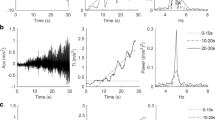Abstract.
The power distribution in the frequency spectrum of tremor is known to vary among individuals and its median power frequency declines with ageing. The purpose of the present study was to determine whether a reduction of the central component of physiological tremor would correlate with a reduction of motor performance. Then, the power distribution in the frequency spectrum of tremor from limb extremities might serve as an index of neural drive in healthy elderly subjects. Rest tremor, postural tremor from the finger, and pronation-supination at the wrist were recorded in 102 healthy nuns living in a convent (mean of 72±12 years). Results reveal that several elderly subjects possessed a power distribution of tremor very similar to that of much younger subjects (mean 27 years±3 SD), showing a preponderance of power within the 7.6- to 12.5-Hz band. Duration of pronation-supination cycles of these elderly subjects was, however, similar to that of other elderly subjects who had a preponderance of power within the 3.6- to 7.5-Hz band. Consequently, healthy elderly subjects who possessed a predominance of power within higher frequencies were not at an advantage over other healthy elderly subjects when performing a pronation-supination task. The age of subjects was, however, a better predictor or motor performance. In conclusion, the present findings suggest that, under normal physiological conditions, a reduction of the central component of physiological tremor does not induce a reduction of motor performance. Consequently, tremor recorded at limb extremities cannot be used as an index of neural drive.
Similar content being viewed by others
Author information
Authors and Affiliations
Additional information
Electronic Publication
Rights and permissions
About this article
Cite this article
Duval, C., Panisset, M. & Sadikot, A.F. The relationship between physiological tremor and the performance of rapid alternating movements in healthy elderly subjects. Exp Brain Res 139, 412–418 (2001). https://doi.org/10.1007/s002210100780
Received:
Accepted:
Issue Date:
DOI: https://doi.org/10.1007/s002210100780




